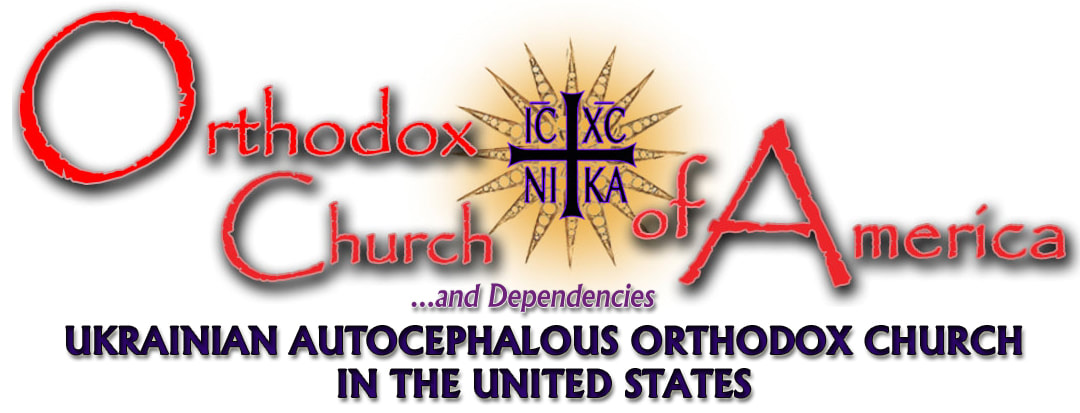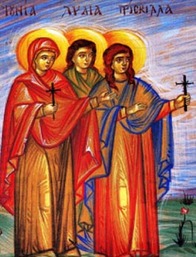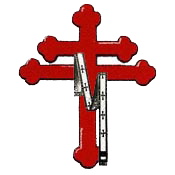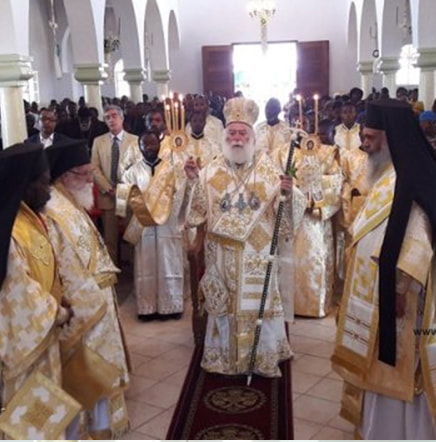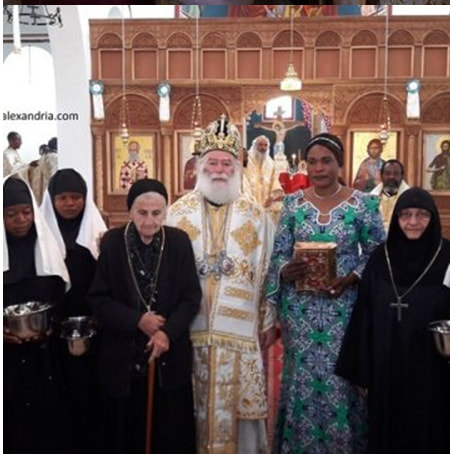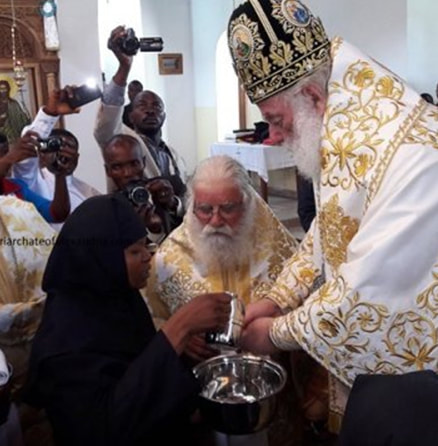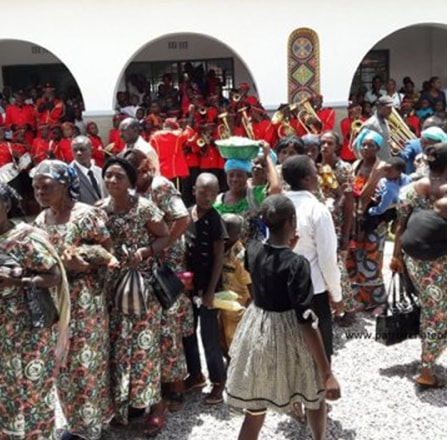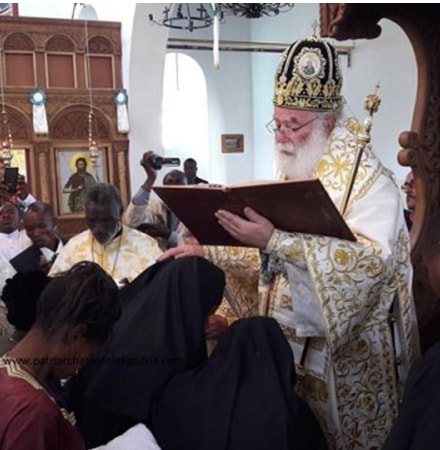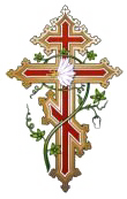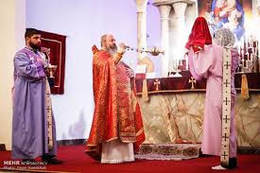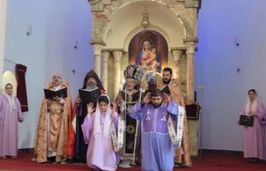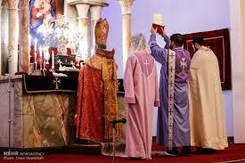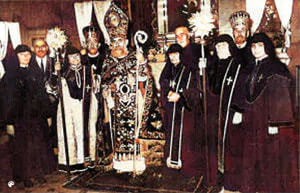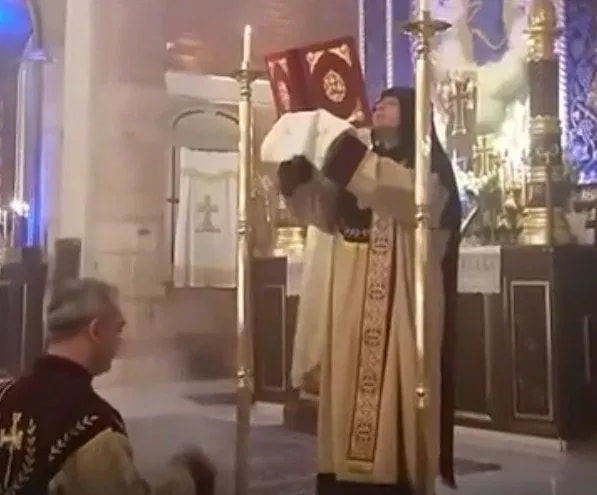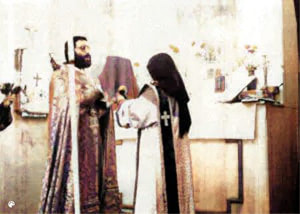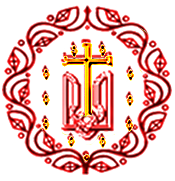The Order of Deaconess
Reflections and Restoration in the Orthodox Church
...don't be told they were subordinate to male Deacons or not in Holy Orders!
...don't be told they were subordinate to male Deacons or not in Holy Orders!
In understanding the restoration of the Order of Deaconess, one must realize that this is not an inovation but, rather, a return to the original discipline and practice of the Orthodox Church that was established by Our Lord Jesus Christ! It has been practiced unbroken in The Armenian Orthodox Church and is currently restored by The Orthodox Church of Greece, the Patriarchate of Alexandria and All Africa, the UOCA and other Orthodox jurisdictions.
It must also be noted that the Order of Deaconess was distinct within itself. Certain "roles" were assigned to male deacons and others to the famale deacons; however, their Liturgical functions were the same at the Holy Altar and documented by the Great Church of Constantinople. Furthermore, it was NOT a step to the Priesthood, which has always been...as the Apostles exampled...restricted to men. If you are a woman, married or single, and you feel called to a vocation as an ordained Deaconess...whether you are a single woman or married...you are invited to contact us with any questions. ~ You may also complete the Formal Application on our Vocations page.
It must also be noted that the Order of Deaconess was distinct within itself. Certain "roles" were assigned to male deacons and others to the famale deacons; however, their Liturgical functions were the same at the Holy Altar and documented by the Great Church of Constantinople. Furthermore, it was NOT a step to the Priesthood, which has always been...as the Apostles exampled...restricted to men. If you are a woman, married or single, and you feel called to a vocation as an ordained Deaconess...whether you are a single woman or married...you are invited to contact us with any questions. ~ You may also complete the Formal Application on our Vocations page.
"I entrust to your care Phoebe, our sister, who is a deaconess of the church which is at Cenchrea." (Romans 16:1, Lamsa Aramaic Bible)
Phoebe, Lydia, Priscilla and other Christian women of Bible times and for almost 800 years afterward were highly honoured in the Orthodox Church as Deaconesses or members of the Order of the Diaconate for Women. They were "servants of the Church" and the leaders and teachers of women. Many a male leader of the Church also attested to the influence of the Deaconess in teaching them in the early formative stages of their lives and fondly referred to them as the "Reverend Mothers," a title by which they are still addressed in the Orthodox Church of America. It is noteworthy that Priscilla, with her husband, Aquilla, took in hand Apollos, a powerful Jewish speaker and convert to Christianity and "showed him the way of the Lord." St. Paul mentions Priscilla in Acts 18:1-3; 18; 26; Romans 16:3 and II Timothy 4:19 and in 3 out of 5 verses she is named before her husband - a very unusual thing in Jewish writing and especially Paul's. His going out of his way to mention Phoebe as a DEACONESS of the Church should be noted, too.
After 800 years of Deaconesses in the Church, the monkish canonists, who obviously had slight regard for women, did away with Deaconesses as they eventually did away withy the hitherto married Bishops and as the Bishop of Rome (at least for the Latin Rite) did away with ANY married person in any part of the priesthood or episcopacy in direct contradiction to the Bible.
The Order of the Diaconate for Women is not properly a part of the regular priesthood but is a special order for women who have the character and the capacity to lead and teach the children and women of the Church and especially assist the Presbyter with them at Holy Baptism.
The Orthodox Catholic priest whose wife is a Deaconess is a fortunate man. Not only is ihis wife his physical helpmate but a spiritual one, too! May God richly bless those holy women who are devoted to the service of His Son, Jesus Christ and, like those wonderful ladies of St. Luke 8:3 minister to Him and to His People.
Archbishop +David (Baxter), SEC
Phoebe, Lydia, Priscilla and other Christian women of Bible times and for almost 800 years afterward were highly honoured in the Orthodox Church as Deaconesses or members of the Order of the Diaconate for Women. They were "servants of the Church" and the leaders and teachers of women. Many a male leader of the Church also attested to the influence of the Deaconess in teaching them in the early formative stages of their lives and fondly referred to them as the "Reverend Mothers," a title by which they are still addressed in the Orthodox Church of America. It is noteworthy that Priscilla, with her husband, Aquilla, took in hand Apollos, a powerful Jewish speaker and convert to Christianity and "showed him the way of the Lord." St. Paul mentions Priscilla in Acts 18:1-3; 18; 26; Romans 16:3 and II Timothy 4:19 and in 3 out of 5 verses she is named before her husband - a very unusual thing in Jewish writing and especially Paul's. His going out of his way to mention Phoebe as a DEACONESS of the Church should be noted, too.
After 800 years of Deaconesses in the Church, the monkish canonists, who obviously had slight regard for women, did away with Deaconesses as they eventually did away withy the hitherto married Bishops and as the Bishop of Rome (at least for the Latin Rite) did away with ANY married person in any part of the priesthood or episcopacy in direct contradiction to the Bible.
The Order of the Diaconate for Women is not properly a part of the regular priesthood but is a special order for women who have the character and the capacity to lead and teach the children and women of the Church and especially assist the Presbyter with them at Holy Baptism.
The Orthodox Catholic priest whose wife is a Deaconess is a fortunate man. Not only is ihis wife his physical helpmate but a spiritual one, too! May God richly bless those holy women who are devoted to the service of His Son, Jesus Christ and, like those wonderful ladies of St. Luke 8:3 minister to Him and to His People.
Archbishop +David (Baxter), SEC
Patriarch Theodoros ll of Alexandria
Performs first Consecration of Deaconesses
On the feast of the Saint and Great Martyr Theodore of Tyre, 17 February 2016, the day on which His Beatitude Theodoros II, Pope and Patriarch of Alexandria and All Africa celebrates his name day, a festive Divine Liturgy was celebrated at the Holy Church of St Nicholas, within the Missionary Centre of Kolwezi.
Together with the Alexandrian Primate concelebrated Their Eminences Nicephorus, Metropolitan of Kinshasa, Innocent, Metropolitan of Burundi and Rwanda, and the local Metropolitan Meletios of Katanga, accompanied by the Clergy of the Hy Metropolis.
Together with the Alexandrian Primate concelebrated Their Eminences Nicephorus, Metropolitan of Kinshasa, Innocent, Metropolitan of Burundi and Rwanda, and the local Metropolitan Meletios of Katanga, accompanied by the Clergy of the Hy Metropolis.
As the official site of the Patriarchate reports, His Beatitude the Patriarch spoke during his homily about the Great Martyr St Theodoros, emphasising the confession of martyrdom before the persecutors of faith and his love for Jesus Christ.
At the end of the Divine Liturgy the Primate of the Alexandrian Throne consecrated the Catechist elder Theano, one of the first members of the Missionary staff in Kolwezi, to “Deaconess of the Missions” of the Holy Metropolis of Katanga and read the prayer for one entering the “Ecclesiastic Ministry” for three Nuns and two Catechists, in order for them to assist the missionary effort of the Holy Metropolis, particularly in the Sacraments of Baptisms of adults and marriages, as well as in the Catechetical department of the local Church.
Note that it is the first time in the history of Missions in Africa that these consecrations have been done.
At the end of the Divine Liturgy the Primate of the Alexandrian Throne consecrated the Catechist elder Theano, one of the first members of the Missionary staff in Kolwezi, to “Deaconess of the Missions” of the Holy Metropolis of Katanga and read the prayer for one entering the “Ecclesiastic Ministry” for three Nuns and two Catechists, in order for them to assist the missionary effort of the Holy Metropolis, particularly in the Sacraments of Baptisms of adults and marriages, as well as in the Catechetical department of the local Church.
Note that it is the first time in the history of Missions in Africa that these consecrations have been done.
Historic 2018 Ordination
of a Deaconess in the the Armenian Orthodox Church
The Primate of the Diocese of Tehran ordained a young woman as a deaconess in Tehran’s St. Sarkis Mother Church on September 25, 2017. Even as the office of deaconess had existed in Armenian Church convents for centuries, this was a historic first. It is the first time that a lay woman, not a nun, was ordained a “parish deacon.”
Twenty-four year old Ani-Kristi Manvelian, an anesthesiologist by profession, was ordained — along with Mayis Mateosian — by Archbishop Sebouh Sarkissian, the Primate of the Diocese of Tehran.
“What I have done is in conformity with the Tradition of the Church and nothing else,” said Archbishop Sarkissian. This was his personal initiative as a diocesan primate in order, as he explained, “to revitalize the participation of women also in our church’s liturgical life,” adding, “do not be surprised, a woman could also become a servant of the Holy Altar.”
Deaconess Ani-Kristi has been involved in the life of the church in Tehran since she was very young. She used to perform the duties of an acolyte (դպիր) during church services, such as reading the psalms and carrying the ceremonial candle.
In explaining the purpose of the ordination, Archbishop Sarkissian said: “Today, our Church is confronting the imperative of self-examination and self-critique. It is imperative to rejuvenate the participation of the people in the social, educational and service spheres of the Church. It is our deep conviction that the active participation of women in the life of our Church would allow Armenian women to be involved more enthusiastically and vigorously, and would allow them to be connected and engaged. They would provide dedicated and loving service [to the people]. The deaconess, no doubt, would also be a spiritual and church-dedicated mother, educator, and why not, a model woman through her example. It is with this deep conviction that we are performing this ordination, with the hope that we are neither the first nor the last to do it.”
According to the Primate, parish priests in Tehran are watchful and keen to recruit more women who fit the profile of prospective deaconesses.
What is special and novel about Deaconess Ani-Kristi Manvelian’s ordination is that she is a “parish” deacon — that is, she is not a member of a convent or a religious order, like the Kalfayan Sisters in Istanbul or Gayanyants Sisters at Birds Nest in Jibel, Lebanon, who have a few sisters among their ranks and are not ordained deaconesses.
Twenty-four year old Ani-Kristi Manvelian, an anesthesiologist by profession, was ordained — along with Mayis Mateosian — by Archbishop Sebouh Sarkissian, the Primate of the Diocese of Tehran.
“What I have done is in conformity with the Tradition of the Church and nothing else,” said Archbishop Sarkissian. This was his personal initiative as a diocesan primate in order, as he explained, “to revitalize the participation of women also in our church’s liturgical life,” adding, “do not be surprised, a woman could also become a servant of the Holy Altar.”
Deaconess Ani-Kristi has been involved in the life of the church in Tehran since she was very young. She used to perform the duties of an acolyte (դպիր) during church services, such as reading the psalms and carrying the ceremonial candle.
In explaining the purpose of the ordination, Archbishop Sarkissian said: “Today, our Church is confronting the imperative of self-examination and self-critique. It is imperative to rejuvenate the participation of the people in the social, educational and service spheres of the Church. It is our deep conviction that the active participation of women in the life of our Church would allow Armenian women to be involved more enthusiastically and vigorously, and would allow them to be connected and engaged. They would provide dedicated and loving service [to the people]. The deaconess, no doubt, would also be a spiritual and church-dedicated mother, educator, and why not, a model woman through her example. It is with this deep conviction that we are performing this ordination, with the hope that we are neither the first nor the last to do it.”
According to the Primate, parish priests in Tehran are watchful and keen to recruit more women who fit the profile of prospective deaconesses.
What is special and novel about Deaconess Ani-Kristi Manvelian’s ordination is that she is a “parish” deacon — that is, she is not a member of a convent or a religious order, like the Kalfayan Sisters in Istanbul or Gayanyants Sisters at Birds Nest in Jibel, Lebanon, who have a few sisters among their ranks and are not ordained deaconesses.
Like her male counterparts in the Armenian Church, if and when Deaconess Ani-Kristi marries, she will continue to serve as a deaconess.
Deaconesses have been part of the Christian tradition from the early years of the faith. There are numerous references in the Epistles and early Church writings.
In the Armenian Church tradition, the development of the office of female diaconate is divided into four historical periods according to Fr. Abel Oghlukian, the author of a study on the subject: (a) 4th-8th centuries in Greater Armenia; (b) 9th-11th centuries in Eastern and Cilician Armenia, where the term “deaconess” is included in the book of ordination (Մաշտոց); (c) 12th century and on, where there are “literary references and rites for the ordination of deaconesses in liturgical texts in Cilicia and eastern Armenia; and (d) 17th century renewal of female diaconate.
The last ordained monastic deaconess in the Armenian Church was Sister Hripsime Sasounian in Istanbul. The late Patriarch Shnork Kalustian of Constantinople ordained Sister Hripsime of Kalfayan Sisters (established in 1866) as a deaconess in 1982, using the same Canon of Ordination used for male deacons (Ձեռնադրութեան Մաշտոց). Damascus-born Deaconess Hripsime was 54 years old at the time. She passed away in 2007.
In North America, Seta Simonian Atamian was the first adult women ordained as an acolyte (դպիր), a lower rank, by Archbishop Vatche Hovsepian of the Western Diocese in 1984 at St. Andrew Armenian Church, in Cupertino, California. However, when in 1986 she moved to the East Coast of the United States, she was not allowed by the local diocese to serve on the altar in the Armenian Church.
Even as this is a most welcome step by Archbishop Sebouh Sarkissian and the Diocese of Tehran (under the jurisdiction of the Catholicosate of Cilicia), the Armenian Apostolic Church has yet to formally restore the office of female diaconate.
Today the question is how to revive the female diaconate for the pastoral life of local parishes rather than in monastic settings or convents, which are virtually non-existent as viable institutions.
Submitted for the Armenian News Agency by Dr. Hratch Tchilingirian, scholar at University of Oxford
Deaconesses have been part of the Christian tradition from the early years of the faith. There are numerous references in the Epistles and early Church writings.
In the Armenian Church tradition, the development of the office of female diaconate is divided into four historical periods according to Fr. Abel Oghlukian, the author of a study on the subject: (a) 4th-8th centuries in Greater Armenia; (b) 9th-11th centuries in Eastern and Cilician Armenia, where the term “deaconess” is included in the book of ordination (Մաշտոց); (c) 12th century and on, where there are “literary references and rites for the ordination of deaconesses in liturgical texts in Cilicia and eastern Armenia; and (d) 17th century renewal of female diaconate.
The last ordained monastic deaconess in the Armenian Church was Sister Hripsime Sasounian in Istanbul. The late Patriarch Shnork Kalustian of Constantinople ordained Sister Hripsime of Kalfayan Sisters (established in 1866) as a deaconess in 1982, using the same Canon of Ordination used for male deacons (Ձեռնադրութեան Մաշտոց). Damascus-born Deaconess Hripsime was 54 years old at the time. She passed away in 2007.
In North America, Seta Simonian Atamian was the first adult women ordained as an acolyte (դպիր), a lower rank, by Archbishop Vatche Hovsepian of the Western Diocese in 1984 at St. Andrew Armenian Church, in Cupertino, California. However, when in 1986 she moved to the East Coast of the United States, she was not allowed by the local diocese to serve on the altar in the Armenian Church.
Even as this is a most welcome step by Archbishop Sebouh Sarkissian and the Diocese of Tehran (under the jurisdiction of the Catholicosate of Cilicia), the Armenian Apostolic Church has yet to formally restore the office of female diaconate.
Today the question is how to revive the female diaconate for the pastoral life of local parishes rather than in monastic settings or convents, which are virtually non-existent as viable institutions.
Submitted for the Armenian News Agency by Dr. Hratch Tchilingirian, scholar at University of Oxford
Here are some reflections on Women Deacons:
His All-Holiness +BARTHOLOMEW I
Archbishop of Constantinople, New Rome and Ecumenical Patriarch...
"As is known, the Ecumenical Patriarchate organized about twenty years ago a special conference in Rhodes to explore the unique role of women in the Orthodox Church. In 1997 we hosted at the Phanar an inter-Orthodox conference with the participation of women, whom we exhorted to make a thorough examination of this expression of diakonia.
We reminded them at the same time that the institution of deaconesses is an indisputable part of our tradition reaching back to the primitive Church."
Ecumenical Patriarchate Inter-Orthodox Theological Consultation: Rhodes, Greece 1988...
THE DIACONATE AND "MINOR ORDERS"
"The Apostolic order of deaconesses should be revived.
It was never altogether abandoned in the Orthodox Church though it has tended to fall into disuse. There is ample evidence, from apostolic times, from the patristic, canonical and liturgical tradition, well into the Byzantine period (and even in our own day) that this order was held in high honour.
The deaconess was ordained within the sanctuary during the Divine Liturgy with two prayers, she received the Orarion (the deacon's stole) and received Holy Communion at the Altar exactly as that of the Deacon. The Rite of Ordination has been preserved from The Great Church of Constantinople.
The revival of this ancient order should be envisaged on the basis of the ancient prototypes testified to in many sources and with the prayers found in the Apostolic Constitutions and the ancient Byzantine liturgical books.
Such a response would represent a positive response to many of the needs and demands of the contemporary world in many spheres. This would be all the more true if the Diaconate in general (male and female) were restored in all places in its original, manifold services (diakonia) with extension in the social sphere, in the spirit of ancient tradition and in response to the special needs of our time. It should not be solely restricted to a purely liturgical role or considered to be a mere step on the way to higher "ranks" of clergy.
The revival of women deacons in the Orthodox Church would emphasize in a special way the dignity of woman and give recognition to her contribution to the work of the Church as a whole."
His Eminence Archbishop +MICHAEL
Greek Orthodox Archdiocese of North & South America, 1953...
"From the very days when the Church was founded, it has pursued a missionary task. And our Saviour Jesus Christ addressed these words to all of those who have continued in the sacred work of the Apostles: 'Go ye, therefore, and teach all nations.' and 'Go ye into all the world, and preach the Gospel to every creature.'
...The missionary character of our Church should be even stronger and more obvious is this great land in which we live, because here besides the Orthodox Church there are many others...
...In order, therefore, that the Greek Orthodox Church be always in complete communion with its members it needs substantial assistance. While it has, of course, its priests, there is so much to be done in each community that the endeavors of these priests alone do not suffice...
...These tremendous needs of the Greek Orthodox Church in America have urged us to make a fervent appeal to our daughters-in-Christ...with the future welfare of our Church and membership at heart, we are considering the establishment in this country of an order of deaconesses...
...Christ continued His work. Christ continues His sacrifice, as He will in the ages to come, so long as there remains even one soul to be saved from sin. He seeks our help. He seeks the assistance of both men and women..."
His Eminence Archbishop +IAKOVOS
Greek Orthodox Archdiocese of North & South America...
Early in his tenure as the successor to Archbishop MICHAEL, Archbishop IAKOVOS also referred to the need for the presence of deaconesses. In his keynote address to the 1960 Clergy-Laity Congress held in Buffalo, New York, in reference to the need for monasticism, missionaries and deaconesses, he stressed...
"No Church exists or can long continue without those who are willing to devote their lives solely in its behalf." The archbishop referred to deaconesses as "additional battalions in the field of battle." He also identified the need to create a school for deaconesses.
In his keynote to the 1962 Clergy-Laity Congress in Boston, Archbishop IAKOVOS emphasized that "the necessity for the establishment of an order of deaconesses has become a crying need more than ever before."
Archbishop of Constantinople, New Rome and Ecumenical Patriarch...
"As is known, the Ecumenical Patriarchate organized about twenty years ago a special conference in Rhodes to explore the unique role of women in the Orthodox Church. In 1997 we hosted at the Phanar an inter-Orthodox conference with the participation of women, whom we exhorted to make a thorough examination of this expression of diakonia.
We reminded them at the same time that the institution of deaconesses is an indisputable part of our tradition reaching back to the primitive Church."
Ecumenical Patriarchate Inter-Orthodox Theological Consultation: Rhodes, Greece 1988...
THE DIACONATE AND "MINOR ORDERS"
"The Apostolic order of deaconesses should be revived.
It was never altogether abandoned in the Orthodox Church though it has tended to fall into disuse. There is ample evidence, from apostolic times, from the patristic, canonical and liturgical tradition, well into the Byzantine period (and even in our own day) that this order was held in high honour.
The deaconess was ordained within the sanctuary during the Divine Liturgy with two prayers, she received the Orarion (the deacon's stole) and received Holy Communion at the Altar exactly as that of the Deacon. The Rite of Ordination has been preserved from The Great Church of Constantinople.
The revival of this ancient order should be envisaged on the basis of the ancient prototypes testified to in many sources and with the prayers found in the Apostolic Constitutions and the ancient Byzantine liturgical books.
Such a response would represent a positive response to many of the needs and demands of the contemporary world in many spheres. This would be all the more true if the Diaconate in general (male and female) were restored in all places in its original, manifold services (diakonia) with extension in the social sphere, in the spirit of ancient tradition and in response to the special needs of our time. It should not be solely restricted to a purely liturgical role or considered to be a mere step on the way to higher "ranks" of clergy.
The revival of women deacons in the Orthodox Church would emphasize in a special way the dignity of woman and give recognition to her contribution to the work of the Church as a whole."
His Eminence Archbishop +MICHAEL
Greek Orthodox Archdiocese of North & South America, 1953...
"From the very days when the Church was founded, it has pursued a missionary task. And our Saviour Jesus Christ addressed these words to all of those who have continued in the sacred work of the Apostles: 'Go ye, therefore, and teach all nations.' and 'Go ye into all the world, and preach the Gospel to every creature.'
...The missionary character of our Church should be even stronger and more obvious is this great land in which we live, because here besides the Orthodox Church there are many others...
...In order, therefore, that the Greek Orthodox Church be always in complete communion with its members it needs substantial assistance. While it has, of course, its priests, there is so much to be done in each community that the endeavors of these priests alone do not suffice...
...These tremendous needs of the Greek Orthodox Church in America have urged us to make a fervent appeal to our daughters-in-Christ...with the future welfare of our Church and membership at heart, we are considering the establishment in this country of an order of deaconesses...
...Christ continued His work. Christ continues His sacrifice, as He will in the ages to come, so long as there remains even one soul to be saved from sin. He seeks our help. He seeks the assistance of both men and women..."
His Eminence Archbishop +IAKOVOS
Greek Orthodox Archdiocese of North & South America...
Early in his tenure as the successor to Archbishop MICHAEL, Archbishop IAKOVOS also referred to the need for the presence of deaconesses. In his keynote address to the 1960 Clergy-Laity Congress held in Buffalo, New York, in reference to the need for monasticism, missionaries and deaconesses, he stressed...
"No Church exists or can long continue without those who are willing to devote their lives solely in its behalf." The archbishop referred to deaconesses as "additional battalions in the field of battle." He also identified the need to create a school for deaconesses.
In his keynote to the 1962 Clergy-Laity Congress in Boston, Archbishop IAKOVOS emphasized that "the necessity for the establishment of an order of deaconesses has become a crying need more than ever before."
EXARCH OF THE ECUMENICAL THRONE WANTED FEMALE DEACONS
His Eminence Archbishop +IAKOVOS, Primate of the Greek Orthodox Archdiocese of North & South America, had great insights for Orthodoxy in the United States. His efforts included return of the Orthodox disciplines for married men being ordained to the Episcopate and Female Deaconesses.
His Eminence called for the re-establishment of the Order of Deaconess along with training programs for qualified women in the Greek Archdiocese.
(READ THE DOCUMENTED ACCOUNT)
His Eminence Archbishop +IAKOVOS, Primate of the Greek Orthodox Archdiocese of North & South America, had great insights for Orthodoxy in the United States. His efforts included return of the Orthodox disciplines for married men being ordained to the Episcopate and Female Deaconesses.
His Eminence called for the re-establishment of the Order of Deaconess along with training programs for qualified women in the Greek Archdiocese.
(READ THE DOCUMENTED ACCOUNT)
Practical Considerations from the Early Church,
for Women Deacons in the Orthodox Church of Today...
for Women Deacons in the Orthodox Church of Today...
The history of the Church clearly indicates women deacons were ordained ministers of the Orthodox Church, and authorized by their bishop to engage in a number of different activities which expressed the Church's mission to lead persons to salvation in Christ.
These three differing ministries could be reduced into three broad, yet distinct, forms of ministry:
FIRST, women deacons frequently had a dynamic, evangelical ministry of teaching the Christian faith to others. They were responsible for instructing believers in the faith and in guiding others in their growth in holiness.
Through their witness and their teachings, numerous women deacons were especially responsible for guiding many pagan and heretical women and men into the Church.
Because of their gift of discernment, many deaconesses were renowned as spiritual mothers. Their intercession, advice, and guidance were sought by both women and men, even ranking members of the clergy.
SECOND, an abundant number of women deacons had a dynamic, evangelical ministry in the area of what would be called today pastoral care and social work. Among their responsibilities, some women deacons devoted their efforts to helping provide food and shelter for the poor.
Others attended to the physically ill and deisabled.
A number of deaconesses were engaged in ministry of providing a safe haven to foreign travelers. People frequently came to these holy women seeking hope, inspiration, and assurance of the love of God during times of trouble and need.
Women deacons were engaged in a ministry both to Christians and non-Christians who were to be found homeless, or in hospitals, hospices, orphanages, and even in prisons. Some women deacons, who were deeply respected for thier mature relationship with God, were able to facilitate the spiritual and physical healing of Christians and other pilgrims who came to them for assistance and counsel.
THIRD, women deacons would also bring Holy Communion to those members of the community who were unable to participate in the Divine Liturgy and would offer prayer and comfort to those in need.
Acting as the ambassador fo the bishop, these deaconesses became the vehicle of the Church's care for the needy and those who appeared to be on the fringes of society...to those who needed Christ and His Church!
Finally, and of great importance to the life of the Church, we have the example of a number of women deacons who exercised a dynamic, evangelical ministry directly related to the life of monastic community."
These three differing ministries could be reduced into three broad, yet distinct, forms of ministry:
FIRST, women deacons frequently had a dynamic, evangelical ministry of teaching the Christian faith to others. They were responsible for instructing believers in the faith and in guiding others in their growth in holiness.
Through their witness and their teachings, numerous women deacons were especially responsible for guiding many pagan and heretical women and men into the Church.
Because of their gift of discernment, many deaconesses were renowned as spiritual mothers. Their intercession, advice, and guidance were sought by both women and men, even ranking members of the clergy.
SECOND, an abundant number of women deacons had a dynamic, evangelical ministry in the area of what would be called today pastoral care and social work. Among their responsibilities, some women deacons devoted their efforts to helping provide food and shelter for the poor.
Others attended to the physically ill and deisabled.
A number of deaconesses were engaged in ministry of providing a safe haven to foreign travelers. People frequently came to these holy women seeking hope, inspiration, and assurance of the love of God during times of trouble and need.
Women deacons were engaged in a ministry both to Christians and non-Christians who were to be found homeless, or in hospitals, hospices, orphanages, and even in prisons. Some women deacons, who were deeply respected for thier mature relationship with God, were able to facilitate the spiritual and physical healing of Christians and other pilgrims who came to them for assistance and counsel.
THIRD, women deacons would also bring Holy Communion to those members of the community who were unable to participate in the Divine Liturgy and would offer prayer and comfort to those in need.
Acting as the ambassador fo the bishop, these deaconesses became the vehicle of the Church's care for the needy and those who appeared to be on the fringes of society...to those who needed Christ and His Church!
Finally, and of great importance to the life of the Church, we have the example of a number of women deacons who exercised a dynamic, evangelical ministry directly related to the life of monastic community."
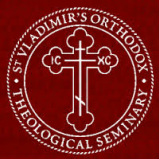
An Article from the leading Orthodox Seminary in the United States that discusses the reality of Deaconesses in the Early Church and explains the proper titles for wives of Deacons, Priests and Bishops.
The Article "Priestesses or Priest's Wives" is taken from the St. Vladimir's Theological Quarterly.
(READ THIS IMPORTANT ARTICLE)
"WOMEN'S ROLE IN THE CHURCH
THE RESTORATION OF THE DIACONATE"
THE RESTORATION OF THE DIACONATE"
by Ellen Gvosdev, USA
Archive: MaryMartha No 3, Summer/Autumn 1993
Women in the church is not one issue but is a topic comprised of many facets. Let us begin with women in the New Testament and Early Church and proceed to their role as saints and their service in the women's diaconate.
Women were the first to hear of Christ's Resurrection, and these women disciples were told to "go and proclaim" the Resurrection. Christ first identified Himself to the woman of Samaria. She is known as St Photeine, the Woman at the Well. Many women travelled with Jesus during His ministry. Some women opened their homes to Him, others were teachers and preachers. St Junia is credited with teaching Apollos about Christianity and bringing him to Christ. We can read about her in the New Testament.
Unfortunately, she is often referred to as Junius, the male form of Junia. Likewise, St Nina, the Evangelizer of Georgia and Equal to the apostles is often called Nino, and both women are referred to as him not her. Prisca or Priscilla, the wife of Aquila, is mentioned before him in the Bible, thus denoting her status in the Christian community. Mary Magdalene was a follower of Christ and a disciple of His Word. The Gospel bears witness to Jesus' chastisement of Martha when she came to Him, angry that her sister Mary was not tending "to the things in the house."
DISTORTION OF WOMEN IN CHURCH HISTORY
Women in Early Church history were seen to be given an equal share. So unlike prior Hebrew tradition, the Church was egalitarian.This history of women's ministry from the New Testament and Early Church should be proclaimed by the Orthodox, yet examples of Junia/Junius, and Nina/Nino only serve as a testament to the distortion of women in Church history.
One woman who stands out in the New Testament is Phoebe, a worker with St Paul, who was the first woman deacon. She was called both diakonos and prostatis, which in those days denoted someone in authority. In the 3rd and 4th centuries, women deacons were common. St John Chrysostom was an advocate of the female diaconate, and letters between him and female deacons have survived. Tombstones serve as another reference. Many can be found bearing witness to female deacons and their ministry. One such example is a tombstone on the Mt. of Olives which bears the inscription, "here lies Sophia the Deacon, a second Phoebe."
Several female deacons became saints. Among them are St Macrina, the sister of Sts. Gregory and Basil; St. Nonna, the wife of St. Gregory Nazianzus; St. Theosebia, the wife of St. Gregory of Nyssa; St. Gorgonia, the daughter of St Gregory the Theologian; St. Melania, St. Susanna, St. Appolonia, St Olympia and St Xenia.
The icon of St. Tatiana shows her wearing the diaconal stole with the words "Holy, Holy,Holy" in Slavonic as is the custom for Russian deacons. She is wearing cuffs, as do our male priests and deacons, and she is holding the censor in one hand, a cross in the other. In the year 535, forty female deacons were employed and serving at Hagia Sophia in Constantinople.
SIMILARITIES OF FEMALE AND MALE DEACONS
Women deacons took Communion from the hands of the bishop in the altar, as do our male priests and deacons today. The female deacons took the chalice from the altar and replaced it on the prothesis table after Communion, as do our male deacons today. Ancient service books attest to the ordination of women deacons, showing the order of ordination, litanies and ordination prayers. Women deacons were ordained right before the Lord's prayer as male deacons are.
The female diaconate peaked in the Early Church, declined in the eighth century and virtually disappeared by the twelfth century, although individual women especially nuns, have been ordained throughout the ages. In 1911,St Nektarios, then a bishop of Greece, ordained a female monastic as a deacon. A few years later, Chrysostomos, Archbishop of Athens did likewise. In 1957, a college for women deacons opened in Greece. Whilst most assume no graduates have ever been ordained, rumours persist that somewhere in Greece, a woman was ordained a deacon this past summer. The restoration of the female diaconate received a lot of press in pre-revolutionary Russia, winning support from several bishops. The Revolution interrupted the Synod which had it on its agenda, the restoration of this order. Many contemporary women and men feel that the restoration of this order is not a stepping stone to the priesthood, but a viable women's ministry, and that it is long overdue in the Orthodox Church.
(original article in THE FORUM publication of the Orthodox Christian Laity)
There is an unprecedented call for the complete restoration for the order of women deacons. Let us Pray for God's Will.
Archive: MaryMartha No 3, Summer/Autumn 1993
Women in the church is not one issue but is a topic comprised of many facets. Let us begin with women in the New Testament and Early Church and proceed to their role as saints and their service in the women's diaconate.
Women were the first to hear of Christ's Resurrection, and these women disciples were told to "go and proclaim" the Resurrection. Christ first identified Himself to the woman of Samaria. She is known as St Photeine, the Woman at the Well. Many women travelled with Jesus during His ministry. Some women opened their homes to Him, others were teachers and preachers. St Junia is credited with teaching Apollos about Christianity and bringing him to Christ. We can read about her in the New Testament.
Unfortunately, she is often referred to as Junius, the male form of Junia. Likewise, St Nina, the Evangelizer of Georgia and Equal to the apostles is often called Nino, and both women are referred to as him not her. Prisca or Priscilla, the wife of Aquila, is mentioned before him in the Bible, thus denoting her status in the Christian community. Mary Magdalene was a follower of Christ and a disciple of His Word. The Gospel bears witness to Jesus' chastisement of Martha when she came to Him, angry that her sister Mary was not tending "to the things in the house."
DISTORTION OF WOMEN IN CHURCH HISTORY
Women in Early Church history were seen to be given an equal share. So unlike prior Hebrew tradition, the Church was egalitarian.This history of women's ministry from the New Testament and Early Church should be proclaimed by the Orthodox, yet examples of Junia/Junius, and Nina/Nino only serve as a testament to the distortion of women in Church history.
One woman who stands out in the New Testament is Phoebe, a worker with St Paul, who was the first woman deacon. She was called both diakonos and prostatis, which in those days denoted someone in authority. In the 3rd and 4th centuries, women deacons were common. St John Chrysostom was an advocate of the female diaconate, and letters between him and female deacons have survived. Tombstones serve as another reference. Many can be found bearing witness to female deacons and their ministry. One such example is a tombstone on the Mt. of Olives which bears the inscription, "here lies Sophia the Deacon, a second Phoebe."
Several female deacons became saints. Among them are St Macrina, the sister of Sts. Gregory and Basil; St. Nonna, the wife of St. Gregory Nazianzus; St. Theosebia, the wife of St. Gregory of Nyssa; St. Gorgonia, the daughter of St Gregory the Theologian; St. Melania, St. Susanna, St. Appolonia, St Olympia and St Xenia.
The icon of St. Tatiana shows her wearing the diaconal stole with the words "Holy, Holy,Holy" in Slavonic as is the custom for Russian deacons. She is wearing cuffs, as do our male priests and deacons, and she is holding the censor in one hand, a cross in the other. In the year 535, forty female deacons were employed and serving at Hagia Sophia in Constantinople.
SIMILARITIES OF FEMALE AND MALE DEACONS
Women deacons took Communion from the hands of the bishop in the altar, as do our male priests and deacons today. The female deacons took the chalice from the altar and replaced it on the prothesis table after Communion, as do our male deacons today. Ancient service books attest to the ordination of women deacons, showing the order of ordination, litanies and ordination prayers. Women deacons were ordained right before the Lord's prayer as male deacons are.
The female diaconate peaked in the Early Church, declined in the eighth century and virtually disappeared by the twelfth century, although individual women especially nuns, have been ordained throughout the ages. In 1911,St Nektarios, then a bishop of Greece, ordained a female monastic as a deacon. A few years later, Chrysostomos, Archbishop of Athens did likewise. In 1957, a college for women deacons opened in Greece. Whilst most assume no graduates have ever been ordained, rumours persist that somewhere in Greece, a woman was ordained a deacon this past summer. The restoration of the female diaconate received a lot of press in pre-revolutionary Russia, winning support from several bishops. The Revolution interrupted the Synod which had it on its agenda, the restoration of this order. Many contemporary women and men feel that the restoration of this order is not a stepping stone to the priesthood, but a viable women's ministry, and that it is long overdue in the Orthodox Church.
(original article in THE FORUM publication of the Orthodox Christian Laity)
There is an unprecedented call for the complete restoration for the order of women deacons. Let us Pray for God's Will.

